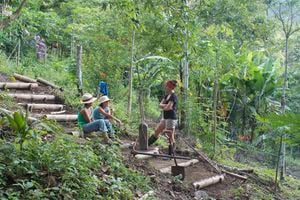
This page is the beginnings of a portal for Ecuador community action in response to Ecological emergency.
Biodiversity[edit | edit source]
Fundación de Conservación Jocotoco[edit | edit source]
Fundación de Conservación Jocotoco (Jocotoco Conservation Foundation) is an Ecuadorian non-governmental environmental organization. It was established to purchase and protect land important to the conservation of endangered birds in Ecuador.
Fundación de Conservación Jocotoco established its first reserve, the Tapichalaca Biological Reserve, in 1998 to protect the type locality and main range of the newly discovered Jocotoco antpitta (Grallaria ridgelyi). The reserve now protects more than 2870 hectares of forest and an associated 380+ species of birds and numerous range-restricted plants, amphibians, mammals, and invertebrates.
Fundación de Conservación Jocotoco has established eleven reserves protecting 16,000 hectares (40,000 acres):
- Ayampe, Dry forest near the Pacific Ocean. Esmeraldas woodstar, great green macaw.
- Buenaventura, wet upper foot hill forest on west slope of Andes. One of only a few localities for El Oro parakeet, and El Oro tapaculo. Also the Giant Caecilian has been found here.
- Chakana (formerly Antisanilla), highland paramo southeast of Quito. Andean condor and spectacled bear.
- Copalinga, wet foot hill forest on eastern slope of Andes, very close to Zamora and Podocarpus National Park.
- Jorupe, Tumbesian dry forest. Henna-hooded foliage-gleaner, rufous-necked foliage-gleaner, blackish-headed spinetail, gray-headed antbird.
- Narupa, wet foothill forest on the east slope of the Andes. Coppery-chested jacamar, Napo sabrewing, many other foothill species.
- Río Canandé, wet Chocó lowlands of the northwest. Scarlet-breasted dacnis, banded ground-cuckoo, great curassow, golden-chested tanager.
- Tapichalaca, wet lower subtropical forest up to páramo on east slope of Andes. Jocotoco antpitta, golden-plumed parakeet, white-necked parakeet, Peruvian antpitta, bicolored antvireo, masked saltator, greater scythebill.
- Utuana, temperate forest on slopes above inter-Andean valley. Piura hemispingus, rainbow starfrontlet, black-crested tit-tyrant.
- Yanacocha, upper temperate forest on Volcán Pichincha. Black-breasted puffleg (one of the few remaining world localities for this critically endangered species), imperial snipe, rainbow-bearded thornbill.
- Yunguilla, woodland south of Cuenca. Only known locality for the critically endangered pale-headed brush-finch.
Fundación de Conservación Jocotoco supports an active research program at the reserves. Projects include:
- Documenting reproductive biology and identifying critical breeding habitat of Esmeraldas woodstar in coastal Ecuador
- Jocotoco Conservation Foundation, added 15:19, 19 December 2023 (UTC)
Biodiversity of Ecuador[edit | edit source]
Ecuador is one of seventeen megadiverse countries in the world according to Conservation International, and it has the most biodiversity per square kilometer of any nation.
Ecuador has 1,600 bird species (15% of the world's known bird species) in the continental area and 38 more endemic in the Galápagos. In addition to more than 16,000 species of plants, the country has 106 endemic reptiles, 138 endemic amphibians, and 6,000 species of butterfly. The Galápagos Islands are well known as a region of distinct fauna, as the famous place of birth to Darwin's Theory of Evolution, and as a UNESCO World Heritage Site.
Ecuador has the first constitution to recognize the rights of nature. The protection of the nation's biodiversity is an explicit national priority as stated in the National Plan of "Buen Vivir", or good living, Objective 4, "Guarantee the rights of nature", Policy 1: "Sustainably conserve and manage the natural heritage, including its land and marine biodiversity, which is considered a strategic sector".
As of the writing of the plan in 2008, 19% of Ecuador's land area was in a protected area; however, the plan also states that 32% of the land must be protected in order to truly preserve the nation's biodiversity. Current protected areas include 11 national parks, 10 wildlife refuges, 9 ecological reserves, and other areas. A program begun in 2008, Sociobosque, is preserving another 2.3% of total land area (6,295 km2, or 629,500 ha) by paying private landowners or community landowners (such as Amerindian tribes) incentives to maintain their land as native ecosystems such as native forests or grasslands. Eligibility and subsidy rates for this program are determined based on the poverty in the region, the number of hectares that will be protected, and the type of ecosystem of the land to be protected, among other factors. Ecuador had a 2018 Forest Landscape Integrity Index mean score of 7.66/10, ranking it 35th globally out of 172 countries.
Despite being on the UNESCO list, the Galápagos are endangered by a range of negative environmental effects, threatening the existence of this exotic ecosystem. Additionally, oil exploitation of the Amazon rainforest has led to the release of billions of gallons of untreated wastes, gas, and crude oil into the environment, contaminating ecosystems and causing detrimental health effects to Amerindian peoples. One of the best known examples is the Texaco-Chevron case. This American oil company operated in the Ecuadorian Amazon region between 1964 and 1992. During this period, Texaco drilled 339 wells in 15 petroleum fields and abandoned 627 toxic wastewater pits. It is now known that these highly polluting and now obsolete technologies were used as a way to reduce expenses.
In 2022, the supreme court of Ecuador decided that "under no circumstances can a project be carried out that generates excessive sacrifices to the collective rights of communities and nature." It also required the government to respect the opinion of Indigenous peoples about different industrial projects on their land.
